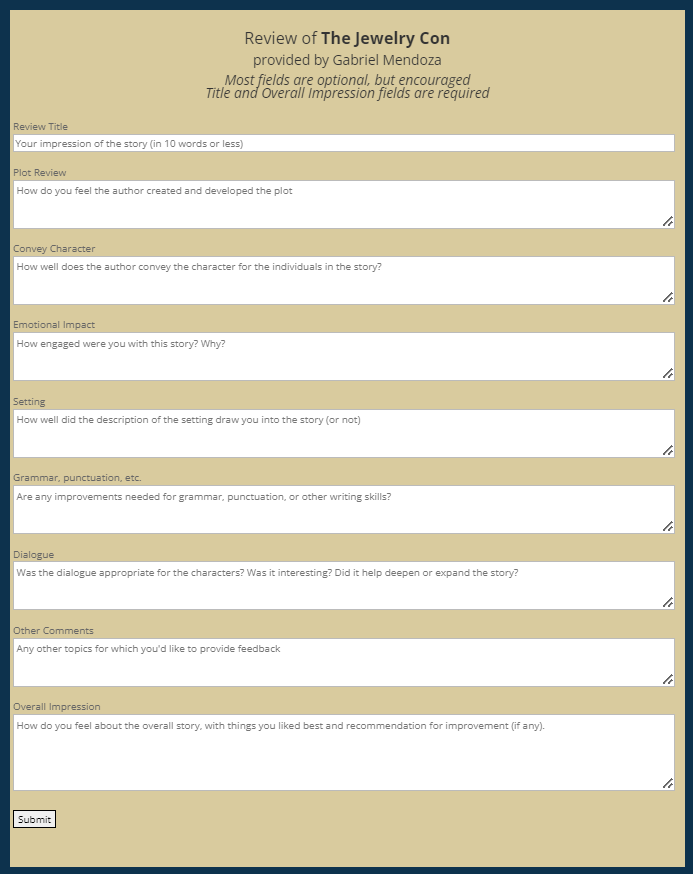Giving and receiving feedback is a crucial part of becoming a great writer. At Create Great Stories, you have the ability to give detailed feedback to the author on the important aspects of their story, along with your general feel for the story and any insights you can provide.
All feedback should be supportive and encouraging. However, supportive doesn’t mean simply providing sentimental cliches without substance. Since everyone is always looking for ways to improve, being supportive means giving very detailed feedback on where the story can be improved, while recognizing areas where the author is doing things well. The combination of identifying areas of strengths and weaknesses in a story, along with ideas how they can be improved, is how we help writers become great writers.
There is a lot to be said for learning one’s own craft by reviewing someone else’s work. Once you’ve found something you like in a story, you can look to incorporate the techniques or ideas into your own work. By identifying aspects that hold a story back from its full potential, you also begin to recognize aspects in your own writing that can be improved.
Remember, we all begin writing from the same place. We are here to encourage each other to tell stories better and have more impact.
Each story contains an “Add Your Review!” box at the end of the story. Click the box to open the feedback form. Your name will be automatically added to the form when it is submitted.


There are only two items required for every Review. The first is a title, which helps differentiate one review from another in the list. The other is the Overall Summary, which provides the author the main parts of the story that you liked or that you believe can be improved.
The Title of the Review should only be ten or less words. Its purpose is to hopefully show an overall impression but with such a short length, usually only conveys a single idea.


Provide the writer with detailed feedback about the plot of the story. Stories don’t necessarily have to have complex plots, but the plot should keep the reader engaged and should move the story along, revealing aspects about the characters based on what they think or how they act.
Does the plot keep moving? Be sure to note if the plot stays engaging through the mid-section where many stories falter. Any ideas about how and where the plot could be strengthened are appreciated.


How interesting are the characters? How well do you understand them? Do they act and react in accordance with who they are and the plot, or do they swing wildly? If they act in unexpected ways, do they do so by intent because the writer is trying to tell us something deep about the character’s underlying motivations, fears, trauma?
Characters do not have to be good. Some of the most recognized characters are bad or even evil. But all characters must be interesting for the reader and preferably memorable. Tell the writer how well they conveyed the important aspects of their characters. Let the writer know if more of a character needs to be revealed or if there is an unexplained inconsistency.
Most writers understand their characters in their own mind, but many times do not realize the story itself does not fully convey that understanding well. The more detailed feedback you can provide in this area, the better for the writer.


A story should keep us emotionally involved. Even stories that are primarily intellectual exercises should still touch our emotions in some way. The deeper the emotions, the more tied we are to the drama and the outcome.
Let the author know if the story has touched your emotions. If the touch has been light, let the author know. If you were moved emotionally in a meaningful way, let the writer know that as well. If you can add specific advice as to how the writer can make the story more emotionally satisfying, give your thoughts and reasons.


Describing the setting well pulls the reader into the story, makes the reader feel a part of the story. A well-constructed setting gives the reader a sense of belonging to the story as if the reader was somehow involved. The right words can convey not just the natural view but also an underlying pervasive feeling and atmosphere, bringing the reader’s emotions into the setting.
Does the writer convey a sense of the location using sights, smell, context? Are there details that make the setting feel familiar even if the location is unknown to the reader? Let the writer know where their setting provided a good enveloping of the setting and atmosphere and where the details of the setting should be enhanced.


A story that has issues with grammar, punctuation, spelling and such detracts the reader from engaging in the story. Let the author know if you find issues or where certain places feel they could be improved.
Please remember to be supportive in this area. Many very good professional writers must employ expensive editors to overcome their weakness in this area, so a lack of innate proficiency doesn’t indicate the writer isn’t able to write very good stories. However, you should tell them specifically what and where an issue detracts from the story.


There’s probably no better way to immediately improve a story than creating crisp, impactful dialogue. Tell the writer when a section of dialogue stood out. Give suggestions to the writer where the dialogue simply provided information but didn’t show the characters engaging in deeper meaning or opposing viewpoints or underlying drama. Two characters engaging in a conversation far deeper than the words they use, but revealed in their sentences and how they speak, can make a story sparkle.


Is there something in the story that wasn’t covered in the other categories? Place any remaining comments in the Other Comments box. The comments can be anything you think would help the story.


Lastly, provide and Overall Impression and summary for your review. This is an area to recap any points as well as provide encouragement and support. Most writers will read this section first, then go back to the other categories for details when they’re making revisions. Keep it brief, hit the high points of both likes and needs for improvement, and any encouragement for the writer.


When everything has been entered, hit the Submit button to record your review. Thanks for reviewing the story!

